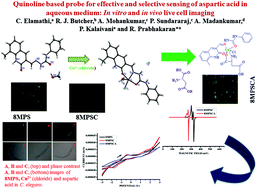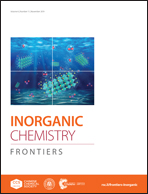A quinoline-based probe for effective and selective sensing of aspartic acid in aqueous medium: in vitro and in vivo live cell imaging†
Abstract
A naturally occurring nitrogen heterocycle-based Schiff base sensor 8-methyl-2-oxo-1,2-dihydroquinoline-3-carboxaldehyde-4N-phenylsemicarbazone (8MPS) was synthesized; a highly sensitive and selective “on–off–on” chemosensor for aspartic acid in aqueous solution was established. In vitro live cell imaging of 8MPS, 8MPSC and 8MPSCA against human breast cancer cells and in vivo imaging using C. elegans as a model have been successfully demonstrated. The sensing probe (8MPS) showed enhanced green fluorescence.



 Please wait while we load your content...
Please wait while we load your content...